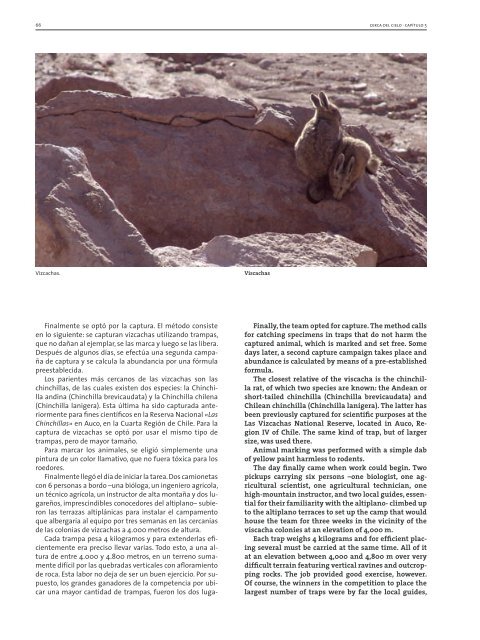Create successful ePaper yourself
Turn your PDF publications into a flip-book with our unique Google optimized e-Paper software.
66 <strong>cerca</strong> <strong>del</strong> <strong>cielo</strong> M capítulo 5<br />
Vizcachas. Viscachas<br />
Finalmente se optó por la captura. El método consiste<br />
en lo siguiente: se capturan vizcachas utilizando trampas,<br />
que no dañan al ejemplar, se las marca y luego se las libera.<br />
Después de algunos días, se efectúa una segunda campaña<br />
de captura y se calcula la abundancia por una fórmula<br />
preestablecida.<br />
Los parientes más <strong>cerca</strong>nos de las vizcachas son las<br />
chinchillas, de las cuales existen dos especies: la Chinchilla<br />
andina (Chinchilla brevicaudata) y la Chinchilla chilena<br />
(Chinchilla lanigera). Esta última ha sido capturada anteriormente<br />
para fines científicos en la Reserva Nacional «Las<br />
Chinchillas» en Auco, en la Cuarta Región de Chile. Para la<br />
captura de vizcachas se optó por usar el mismo tipo de<br />
trampas, pero de mayor tamaño.<br />
Para marcar los animales, se eligió simplemente una<br />
pintura de un color llamativo, que no fuera tóxica para los<br />
roedores.<br />
Finalmente llegó el día de iniciar la tarea. Dos camionetas<br />
con 6 personas a bordo –una bióloga, un ingeniero agrícola,<br />
un técnico agrícola, un instructor de alta montaña y dos lugareños,<br />
imprescindibles conocedores <strong>del</strong> altiplano– subieron<br />
las terrazas altiplánicas para instalar el campamento<br />
que albergaría al equipo por tres semanas en las <strong>cerca</strong>nías<br />
de las colonias de vizcachas a 4.000 metros de altura.<br />
Cada trampa pesa 4 kilogramos y para extenderlas eficientemente<br />
era preciso llevar varias. Todo esto, a una altura<br />
de entre 4.000 y 4.800 metros, en un terreno sumamente<br />
difícil por las quebradas verticales con afloramiento<br />
de roca. Esta labor no deja de ser un buen ejercicio. Por supuesto,<br />
los grandes ganadores de la competencia por ubicar<br />
una mayor cantidad de trampas, fueron los dos luga-<br />
Finally, the team opted for capture. The method calls<br />
for catching specimens in traps that do not harm the<br />
captured animal, which is marked and set free. Some<br />
days later, a second capture campaign takes place and<br />
abundance is calculated by means of a pre-established<br />
formula.<br />
The closest relative of the viscacha is the chinchilla<br />
rat, of which two species are known: the Andean or<br />
short-tailed chinchilla (Chinchilla brevicaudata) and<br />
Chilean chinchilla (Chinchilla lanigera). The latter has<br />
been previously captured for scientific purposes at the<br />
Las Vizcachas National Reserve, located in Auco, Region<br />
IV of Chile. The same kind of trap, but of larger<br />
size, was used there.<br />
Animal marking was performed with a simple dab<br />
of yellow paint harmless to rodents.<br />
The day finally came when work could begin. Two<br />
pickups carrying six persons –one biologist, one agricultural<br />
scientist, one agricultural technician, one<br />
high-mountain instructor, and two local guides, essential<br />
for their familiarity with the altiplano- climbed up<br />
to the altiplano terraces to set up the camp that would<br />
house the team for three weeks in the vicinity of the<br />
viscacha colonies at an elevation of 4,000 m.<br />
Each trap weighs 4 kilograms and for efficient placing<br />
several must be carried at the same time. All of it<br />
at an elevation between 4,000 and 4,800 m over very<br />
difficult terrain featuring vertical ravines and outcropping<br />
rocks. The job provided good exercise, however.<br />
Of course, the winners in the competition to place the<br />
largest number of traps were by far the local guides,

















